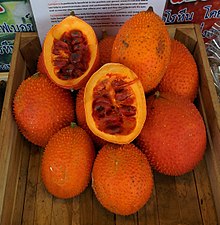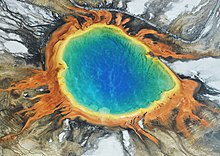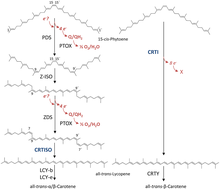Carotenoid

Carotenoids (
All are derivatives of tetraterpenes, meaning that they are produced from 8 isoprene units and contain 40 carbon atoms. In general, carotenoids absorb wavelengths ranging from 400 to 550 nanometers (violet to green light). This causes the compounds to be deeply colored yellow, orange, or red. Carotenoids are the dominant pigment in autumn leaf coloration of about 15-30% of tree species,[3] but many plant colors, especially reds and purples, are due to polyphenols.

Carotenoids serve two key roles in plants and algae: they absorb light energy for use in
Structure and function



Carotenoids are produced by all photosynthetic organisms and are primarily used as accessory pigments to chlorophyll in the light-harvesting part of photosynthesis.
They are highly
Most carotenoids are
Carotenoids also participate in different types of cell signaling.[7] They are able to signal the production of abscisic acid, which regulates plant growth, seed dormancy, embryo maturation and germination, cell division and elongation, floral growth, and stress responses.[8]
Photophysics
The length of the multiple conjugated double bonds determines their color and photophysics.[9][10] After absorbing a photon, the carotenoid transfers its excited electron to chlorophyll for use in photosynthesis.[9] Upon absorption of light, carotenoids transfer excitation energy to and from chlorophyll. The singlet-singlet energy transfer is a lower energy state transfer and is used during photosynthesis.[7] The triplet-triplet transfer is a higher energy state and is essential in photoprotection.[7] Light produces damaging species during photosynthesis, with the most damaging being reactive oxygen species (ROS). As these high energy ROS are produced in the chlorophyll the energy is transferred to the carotenoid’s polyene tail and undergoes a series of reactions in which electrons are moved between the carotenoid bonds in order to find the most balanced (lowest energy) state for the carotenoid.[9]
Carotenoids defend plants against singlet oxygen, by both energy transfer and by chemical reactions. They also protect plants by quenching triplet chlorophyll.[11] By protecting lipids from free-radical damage, which generate charged lipid peroxides and other oxidised derivatives, carotenoids support crystalline architecture and hydrophobicity of lipoproteins and cellular lipid structures, hence oxygen solubility and its diffusion therein.[12]
Structure-property relationships
Like some
Morphology
Carotenoids are located primarily outside the
With the development of monoclonal antibodies to trans-lycopene it was possible to localise this carotenoid in different animal and human cells.[15]

Foods
Reviews of preliminary research in 2015 indicated that foods high in carotenoids may reduce the risk of
Humans and other
Carotenoids from the diet are stored in the fatty tissues of animals,[3] and exclusively carnivorous animals obtain the compounds from animal fat. In the human diet, absorption of carotenoids is improved when consumed with fat in a meal.[24] Cooking carotenoid-containing vegetables in oil and shredding the vegetable both increase carotenoid bioavailability.[3][24][25]
Plant colors


The most common carotenoids include lycopene and the vitamin A precursor β-carotene. In plants, the xanthophyll lutein is the most abundant carotenoid and its role in preventing age-related eye disease is currently under investigation.[5] Lutein and the other carotenoid pigments found in mature leaves are often not obvious because of the masking presence of chlorophyll. When chlorophyll is not present, as in autumn foliage, the yellows and oranges of the carotenoids are predominant. For the same reason, carotenoid colors often predominate in ripe fruit after being unmasked by the disappearance of chlorophyll.
Carotenoids are responsible for the brilliant yellows and oranges that tint
Bird colors and sexual selection
Dietary carotenoids and their metabolic derivatives are responsible for bright yellow to red coloration in birds.[28] Studies estimate that around 2956 modern bird species display carotenoid coloration and that the ability to utilize these pigments for external coloration has evolved independently many times throughout avian evolutionary history.[29] Carotenoid coloration exhibits high levels of sexual dimorphism, with adult male birds generally displaying more vibrant coloration than females of the same species.[30]
These differences arise due to the selection of yellow and red coloration in males by female preference.[31][30] In many species of birds, females invest greater time and resources into raising offspring than their male partners. Therefore, it is imperative that female birds carefully select high quality mates. Current literature supports the theory that vibrant carotenoid coloration is correlated with male quality—either though direct effects on immune function and oxidative stress,[32][33][34] or through a connection between carotenoid metabolizing pathways and pathways for cellular respiration.[35][36]
It is generally considered that sexually selected traits, such as carotenoid-based coloration, evolve because they are honest signals of phenotypic and genetic quality. For instance, among males of the bird species Parus major, the more colorfully ornamented males produce sperm that is better protected against oxidative stress due to increased presence of carotenoid antioxidants.[37] However, there is also evidence that attractive male coloration may be a faulty signal of male quality. Among stickleback fish, males that are more attractive to females due to carotenoid colorants appear to under-allocate carotenoids to their germline cells.[38] Since carotinoids are beneficial antioxidants, their under-allocation to germline cells can lead to increased oxidative DNA damage to these cells.[38] Therefore, female sticklebacks may risk fertility and the viability of their offspring by choosing redder, but more deteriorated partners with reduced sperm quality.
Aroma chemicals
Products of carotenoid degradation such as ionones, damascones and damascenones are also important fragrance chemicals that are used extensively in the perfumes and fragrance industry. Both β-damascenone and β-ionone although low in concentration in rose distillates are the key odor-contributing compounds in flowers. In fact, the sweet floral smells present in black tea, aged tobacco, grape, and many fruits are due to the aromatic compounds resulting from carotenoid breakdown.
Disease
Some carotenoids are produced by bacteria to protect themselves from oxidative immune attack. The aureus (golden) pigment that gives some strains of Staphylococcus aureus their name is a carotenoid called staphyloxanthin. This carotenoid is a virulence factor with an antioxidant action that helps the microbe evade death by reactive oxygen species used by the host immune system.[39]
Biosynthesis

The basic building blocks of carotenoids are
MEP pathway
Carotenoid biosynthetic pathway

Two GGPP molecules condense via
This all-trans lycopene is cyclized;
Regulation
It is believed that both DXS and DXR are rate-determining enzymes, allowing them to regulate carotenoid levels.
Naturally occurring carotenoids
- Hydrocarbons
- Lycopersene 7,8,11,12,15,7',8',11',12',15'-Decahydro-γ,γ-carotene
- Phytofluene
- Lycopene
- Hexahydrolycopene 15-cis-7,8,11,12,7',8'-Hexahydro-γ,γ-carotene
- Torulene 3',4'-Didehydro-β,γ-carotene
- α-Zeacarotene 7',8'-Dihydro-ε,γ-carotene
- α-Carotene
- β-Carotene
- γ-Carotene
- δ-Carotene
- ε-Carotene
- ζ-Carotene
- Alcohols
- Alloxanthin
- Bacterioruberin2,2'-Bis(3-hydroxy-3-methylbutyl)-3,4,3',4'-tetradehydro-1,2,1',2'-tetrahydro-γ,γ-carotene-1,1'-diol
- Cynthiaxanthin
- Pectenoxanthin
- Cryptomonaxanthin (3R,3'R)-7,8,7',8'-Tetradehydro-β,β-carotene-3,3'-diol
- Crustaxanthin β,-Carotene-3,4,3',4'-tetrol
- Gazaniaxanthin (3R)-5'-cis-β,γ-Caroten-3-ol
- OH-Chlorobactene 1',2'-Dihydro-f,γ-caroten-1'-ol
- Loroxanthin β,ε-Carotene-3,19,3'-triol
- Lutein (3R,3′R,6′R)-β,ε-carotene-3,3′-diol
- Lycoxanthin γ,γ-Caroten-16-ol
- Rhodopin 1,2-Dihydro-γ,γ-caroten-l-ol
- Rhodopinol a.k.a. Warmingol 13-cis-1,2-Dihydro-γ,γ-carotene-1,20-diol
- Saproxanthin 3',4'-Didehydro-1',2'-dihydro-β,γ-carotene-3,1'-diol
- Zeaxanthin
- Glycosides
- Oscillaxanthin 2,2'-Bis(β-L-rhamnopyranosyloxy)-3,4,3',4'-tetradehydro-1,2,1',2'-tetrahydro-γ,γ-carotene-1,1'-diol
- Phleixanthophyll 1'-(β-D-Glucopyranosyloxy)-3',4'-didehydro-1',2'-dihydro-β,γ-caroten-2'-ol
- Ethers
- Rhodovibrin 1'-Methoxy-3',4'-didehydro-1,2,1',2'-tetrahydro-γ,γ-caroten-1-ol
- Spheroidene 1-Methoxy-3,4-didehydro-1,2,7',8'-tetrahydro-γ,γ-carotene
- Epoxides
- Diadinoxanthin 5,6-Epoxy-7',8'-didehydro-5,6-dihydro—carotene-3,3-diol
- Luteoxanthin 5,6: 5',8'-Diepoxy-5,6,5',8'-tetrahydro-β,β-carotene-3,3'-diol
- Mutatoxanthin
- Citroxanthin
- Zeaxanthin furanoxide 5,8-Epoxy-5,8-dihydro-β,β-carotene-3,3'-diol
- Neochrome 5',8'-Epoxy-6,7-didehydro-5,6,5',8'-tetrahydro-β,β-carotene-3,5,3'-triol
- Foliachrome
- Trollichrome
- Vaucheriaxanthin 5',6'-Epoxy-6,7-didehydro-5,6,5',6'-tetrahydro-β,β-carotene-3,5,19,3'-tetrol
- Aldehydes
- Rhodopinal
- Warmingone 13-cis-1-Hydroxy-1,2-dihydro-γ,γ-caroten-20-al
- Torularhodinaldehyde 3',4'-Didehydro-β,γ-caroten-16'-al
- Acids and acid esters
- Torularhodin 3',4'-Didehydro-β,γ-caroten-16'-oic acid
- Torularhodin methyl ester Methyl 3',4'-didehydro-β,γ-caroten-16'-oate
- Ketones
- Astacene
- Astaxanthin
- Canthaxanthin[44] a.k.a. Aphanicin, Chlorellaxanthin β,β-Carotene-4,4'-dione
- Capsanthin (3R,3'S,5'R)-3,3'-Dihydroxy-β,κ-caroten-6'-one
- Capsorubin (3S,5R,3'S,5'R)-3,3'-Dihydroxy-κ,κ-carotene-6,6'-dione
- Cryptocapsin (3'R,5'R)-3'-Hydroxy-β,κ-caroten-6'-one
- 2,2'-Diketospirilloxanthin 1,1'-Dimethoxy-3,4,3',4'-tetradehydro-1,2,1',2'-tetrahydro-γ,γ-carotene-2,2'-dione
- Echinenone β,β-Caroten-4-one
- 3'-Hydroxyechinenone
- Flexixanthin 3,1'-Dihydroxy-3',4'-didehydro-1',2'-dihydro-β,γ-caroten-4-one
- 3-OH-Canthaxanthin a.k.a. Adonirubin a.k.a. Phoenicoxanthin 3-Hydroxy-β,β-carotene-4,4'-dione
- Hydroxyspheriodenone 1'-Hydroxy-1-methoxy-3,4-didehydro-1,2,1',2',7',8'-hexahydro-γ,γ-caroten-2-one
- Okenone 1'-Methoxy-1',2'-dihydro-c,γ-caroten-4'-one
- Pectenolone 3,3'-Dihydroxy-7',8'-didehydro-β,β-caroten-4-one
- Phoeniconone a.k.a. Dehydroadonirubin 3-Hydroxy-2,3-didehydro-β,β-carotene-4,4'-dione
- Phoenicopterone β,ε-caroten-4-one
- Rubixanthone 3-Hydroxy-β,γ-caroten-4'-one
- Siphonaxanthin 3,19,3'-Trihydroxy-7,8-dihydro-β,ε-caroten-8-one
- Esters of alcohols
- Astacein 3,3'-Bispalmitoyloxy-2,3,2',3'-tetradehydro-β,β-carotene-4,4'-dione or 3,3'-dihydroxy-2,3,2',3'-tetradehydro-β,β-carotene-4,4'-dione dipalmitate
- Fucoxanthin 3'-Acetoxy-5,6-epoxy-3,5'-dihydroxy-6',7'-didehydro-5,6,7,8,5',6'-hexahydro-β,β-caroten-8-one
- Isofucoxanthin 3'-Acetoxy-3,5,5'-trihydroxy-6',7'-didehydro-5,8,5',6'-tetrahydro-β,β-caroten-8-one
- Physalien
- Siphonein 3,3'-Dihydroxy-19-lauroyloxy-7,8-dihydro-β,ε-caroten-8-one or 3,19,3'-trihydroxy-7,8-dihydro-β,ε-caroten-8-one 19-laurate
- Apocarotenoids
- β-Apo-2'-carotenal 3',4'-Didehydro-2'-apo-b-caroten-2'-al
- Apo-2-lycopenal
- Apo-6'-lycopenal 6'-Apo-y-caroten-6'-al
- Azafrinaldehyde 5,6-Dihydroxy-5,6-dihydro-10'-apo-β-caroten-10'-al
- Bixin 6'-Methyl hydrogen 9'-cis-6,6'-diapocarotene-6,6'-dioate
- Citranaxanthin 5',6'-Dihydro-5'-apo-β-caroten-6'-one or 5',6'-dihydro-5'-apo-18'-nor-β-caroten-6'-one or 6'-methyl-6'-apo-β-caroten-6'-one
- Crocetin 8,8'-Diapo-8,8'-carotenedioic acid
- Crocetinsemialdehyde 8'-Oxo-8,8'-diapo-8-carotenoic acid
- Crocin Digentiobiosyl 8,8'-diapo-8,8'-carotenedioate
- Hopkinsiaxanthin 3-Hydroxy-7,8-didehydro-7',8'-dihydro-7'-apo-b-carotene-4,8'-dione or 3-hydroxy-8'-methyl-7,8-didehydro-8'-apo-b-carotene-4,8'-dione
- Methyl apo-6'-lycopenoate Methyl 6'-apo-y-caroten-6'-oate
- Paracentrone 3,5-Dihydroxy-6,7-didehydro-5,6,7',8'-tetrahydro-7'-apo-b-caroten-8'-one or 3,5-dihydroxy-8'-methyl-6,7-didehydro-5,6-dihydro-8'-apo-b-caroten-8'-one
- Sintaxanthin 7',8'-Dihydro-7'-apo-b-caroten-8'-one or 8'-methyl-8'-apo-b-caroten-8'-one
- Nor- and seco-carotenoids
- Actinioerythrin 3,3'-Bisacyloxy-2,2'-dinor-b,b-carotene-4,4'-dione
- β-Carotenone 5,6:5',6'-Diseco-b,b-carotene-5,6,5',6'-tetrone
- Peridinin 3'-Acetoxy-5,6-epoxy-3,5'-dihydroxy-6',7'-didehydro-5,6,5',6'-tetrahydro-12',13',20'-trinor-b,b-caroten-19,11-olide
- Pyrrhoxanthininol 5,6-epoxy-3,3'-dihydroxy-7',8'-didehydro-5,6-dihydro-12',13',20'-trinor-b,b-caroten-19,11-olide
- Semi-α-carotenone 5,6-Seco-b,e-carotene-5,6-dione
- Semi-β-carotenone 5,6-seco-b,b-carotene-5,6-dione or 5',6'-seco-b,b-carotene-5',6'-dione
- Triphasiaxanthin 3-Hydroxysemi-b-carotenone 3'-Hydroxy-5,6-seco-b,b-carotene-5,6-dione or 3-hydroxy-5',6'-seco-b,b-carotene-5',6'-dione
- Retro-carotenoids and retro-apo-carotenoids
- Eschscholtzxanthin 4',5'-Didehydro-4,5'-retro-b,b-carotene-3,3'-diol
- Eschscholtzxanthone 3'-Hydroxy-4',5'-didehydro-4,5'-retro-b,b-caroten-3-one
- Rhodoxanthin 4',5'-Didehydro-4,5'-retro-b,b-carotene-3,3'-dione
- Tangeraxanthin 3-Hydroxy-5'-methyl-4,5'-retro-5'-apo-b-caroten-5'-one or 3-hydroxy-4,5'-retro-5'-apo-b-caroten-5'-one
- Higher carotenoids
- Nonaprenoxanthin 2-(4-Hydroxy-3-methyl-2-butenyl)-7',8',11',12'-tetrahydro-e,y-carotene
- Decaprenoxanthin 2,2'-Bis(4-hydroxy-3-methyl-2-butenyl)-e,e-carotene
- C.p. 450 2-[4-Hydroxy-3-(hydroxymethyl)-2-butenyl]-2'-(3-methyl-2-butenyl)-b,b-carotene
- C.p. 473 2'-(4-Hydroxy-3-methyl-2-butenyl)-2-(3-methyl-2-butenyl)-3',4'-didehydro-l',2'-dihydro-β,γ-caroten-1'-ol
- Bacterioruberin2,2'-Bis(3-hydroxy-3-methylbutyl)-3,4,3',4'-tetradehydro-1,2,1',2'-tetrahydro-γ,γ-carotene-1,1'-diol
See also
- List of phytochemicals in food
- CRT (genetics), gene cluster responsible for the biosynthesis of carotenoids
- E number#E100–E199 (colours)
- Phytochemistry
References
- ISBN 0-7167-4339-6.
- PMID 28365725.
- ^ a b c d e f g h i j "Carotenoids". Micronutrient Information Center, Linus Pauling Institute, Oregon State University. 1 August 2016. Retrieved 17 April 2019.
- S2CID 22385652.
- ^ PMID 26541886.
- PMID 18676669.
- ^ ISSN 0080-4622.
- PMID 24273463.
- ^ S2CID 24408277.
- PMID 15080720.
- PMID 22234998.
- OCLC 148650411.
- ISBN 978-0-7923-5942-5, retrieved 2021-03-28
- S2CID 54807067
- S2CID 49190846.
- ^ "Foods Highest in Retinol Activity Equivalent". nutritiondata.self.com. Retrieved 2015-12-04.
- PMID 27004120.
- PMID 26553382.
- S2CID 21131127.
- PMID 26058846.
- S2CID 12396064.
- .
- S2CID 8655801.
- ^ PMID 28242932.
- PMID 25996796.
- PMID 19178979.
- ISBN 978-1-4051-1737-1.
- ISSN 0269-8463.
- PMID 24966316.
- ^ PMID 30992444.
- S2CID 53176725.
- PMID 29311592.
- PMID 22905205.
- ISSN 0269-8463.
- S2CID 2013258.
- PMID 33940618.
- PMID 20059524.
- ^ S2CID 204702365.
- PMID 16009720.
- ^ S2CID 26818009.
- ^ PMID 22450534.
- PMID 24175570.
- S2CID 26818009.
- PMID 15823009.
External links
- Carotenoids at the U.S. National Library of Medicine Medical Subject Headings (MeSH)

